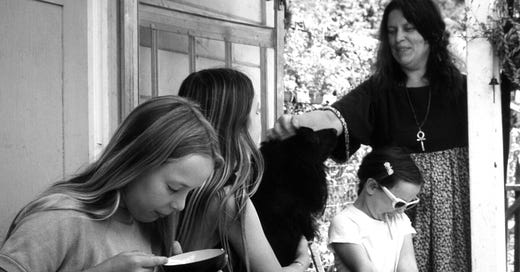“I don't think I looked at the new kids as anything but kids.”
Old-timer respondent who was a child in 1970.s
The Comptche School serves grades K-4, students from 5th grade on up are bussed to Mendocino on the coast. Back-to-the-land parents wanted to integrate the community into the curriculum, so they arranged field trips for the students, such as visiting local ranches. A few back-to-the-lander parents taught chess, another taught guitar.
Non-academic pedagogy was met with some resistance from old-timers who felt things were fine before the newcomers came along.

“I liked things the way they were. There used to be more community things, everybody was part of the Grange. But then there were too many people, the newcomers made for too many, like with the Christmas party. We used to buy a gift for every child, but then there were too many kids. The school Christmas play had to end and then it was put on by the Sunday school.”
The above statement was written by an old-timer respondent from a long-established Comptche family. She was a mother raising kids during the 1950s - 1970s, and was very open with me in interviews about how children represented change in the 1970s.
Old-timer parents feared the back-to-the-lander kids would influence their children in counterculture mores such as smoking pot, not bathing, and lack of rules.
"I can remember being fearful of some of the hippie parents. Mostly because of their appearance, but also because they were so different from our parents.” Respondent who was an old-timer family kid.
“When I went to my friends’ who were old-timers, sometimes I stayed for dinner or spent the night. But those moms never let their daughters hang out at my house. Not once.”
However, the impact of one another’s children is a two-way road. As a back-to-the-land kid, I was greatly influenced by the old-time local “straight” kids.
I wanted to be more like them, so I dressed differently and tamed my language, went to their summer bible camp, and never fit in. Both metaphorically and literally, I was the chubby friend to a girl in the “Thin” family who gets invited waterskiing. I agonize over my adolescent belly and the longing to learn a middle class sport, wanting to be with my friend, while knowing I’m tolerated because I can be saved. Converted. My own groovy people always welcome me home with hugs and fresh bread, dinner that’s soon, and wanting to hear about my adventures.
"Had a hard time with the 'squares vs. heads' tension created by the adults.” Respondent who was a back-to-land kid.
The friendships between the children of new and established families helped to bring long-term change to Comptche, but still didn’t bridge their parents’ values gap. The adults had to do their own work. And, as we will see, they did.
The significance of children in this study is in finding they formed friendships in spite of their parents’ conflicting ideology. In many cases, differences were appealing to the equally curious children of The Other.
While many young people moved away after high school, among those who remain, there are inter-family marriages and friendships lasting into the future. Children became friends despite their ideologically opposed parents, and were unwitting agents of change.
Next Up: Sources of Livelihood
References for this post:
This is original research. For use, please credit:
Spicer, Lisa Gruwell, 2012. Collective Effervescence: When the Hippie Counterculture Immigrated to a Rural Redwood Community. Western Washington University.






